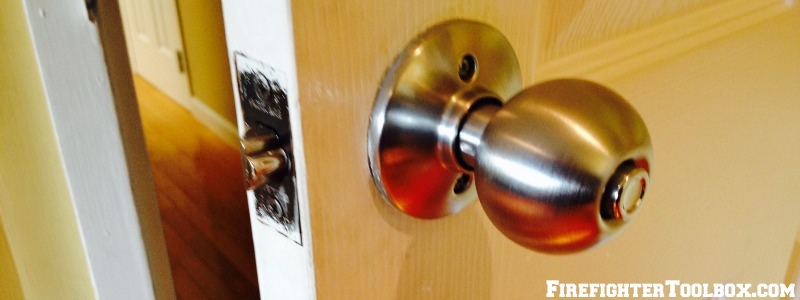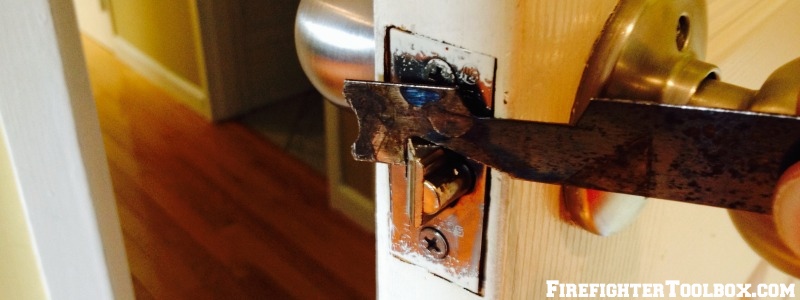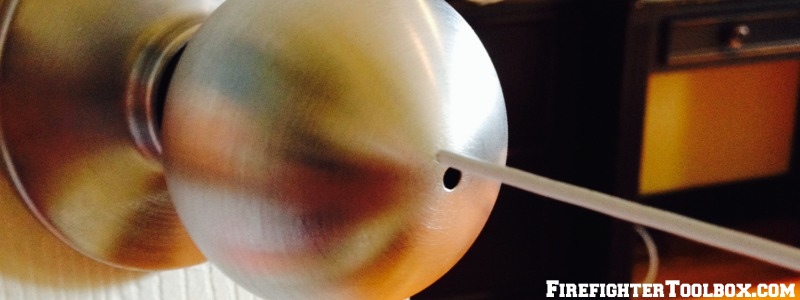Fundamentals of Going Through The Lock – Part 1
Forcible entry can take on many roles. Occasionally, we may encounter locked doors on alarms that aren’t of a high priority. By accessing any area without creating much damage to EMS alarms, automatic alarms or any alarm, we behave more professionally.
Two possible locks that we normally come across are the slam lock and the key-in-the-knob lock. Although these two locks are simple and really not that difficult to defeat, many take them for granted. They do not put the time in training to get past them quickly, efficiently and with the least amount of damage possible.
In Part 1 of this 2-part series, we will look at slam lock and how we can overcome them with minimal damage.
Slam Lock
A lock that we commonly find on the interior doors of most private dwellings and occasionally, in commercial buildings, is the slam lock. It is extremely simple in design; the lock mechanism is usually just a push button at the back of the knob or a half turn of the knob.
If you look at the photo below, you will see what’s known as a “tamper pin” or an “anti-loitering pin”. If pushed in, this pin prevents the latch from operating. However, this is usually not a factor in bypassing the lock because the vast majority of doors are either misaligned in the frame or not installed properly to begin with, which basically takes this pin out of play. There are three methods we can use to bypass this lock quickly and easily which I will explain below.

#1 – Shove Knife (Shove Tool)
A shove knife is a versatile tool that can be used on both inward and outward swinging doors. However, it generally works better on the latter. To bypass the lock on an outward swinging door, simply insert the tool above the lock as shown in the photo below. Then, pull the tool down and towards you. The door should open. It is advisable to put pressure on the bottom of the door with your foot or to move the door in and out in the jam to make the process easier.
While working extremely well on outward swinging doors, using shove knife on inward swinging doors will take a bit more practice. Moreover, depending on the jam that is installed, inward swinging doors may give you quite a bit of trouble to the point where it may be best to switch to an easier technique.

#2 – Coat Hanger
If you encounter a locked door with no keyhole or other visible signs of locks, you are most likely looking at a slam latch. The easiest way to defeat this lock is to simply find the hole in the door knob and insert a section of a metal coat hanger into it. As it hits the lock mechanism, you will feel some resistance. A simple push will unlock the door and you are in. If you don’t have a coat hanger, any other similar metal could work such as a paper clip, hair clip, etc.

#3 – Two-Liter Soda Bottle
This is without a doubt a cool trick and will cost nothing to make. What you have to do is to simply cut out the center section of a 2-liter soda bottle. As the cutout is light and can be easily rolled up, it also takes up no space and can be kept in your gear.
For locks on inward opening doors, simply push the soda bottle around the door. Angle it up about 45 degrees and slide back and forth with a sawing motion periodically to take pressure off the door. You can also use this to check if dead bolts are engaged by sliding it down to the lock. If resistance is met, the lock is engaged.
Credit has to be given to Will Dering from 10-75 Training for teaching me this technique. You can view how to make this tool here.
In next part of the series, we will take a look at the additional ways you can defeat the slam lock as well as the key-in-the-knob lock. If you have any through-the-lock tips, please share them in the comments section.
Photo Credit: Robert Fling









